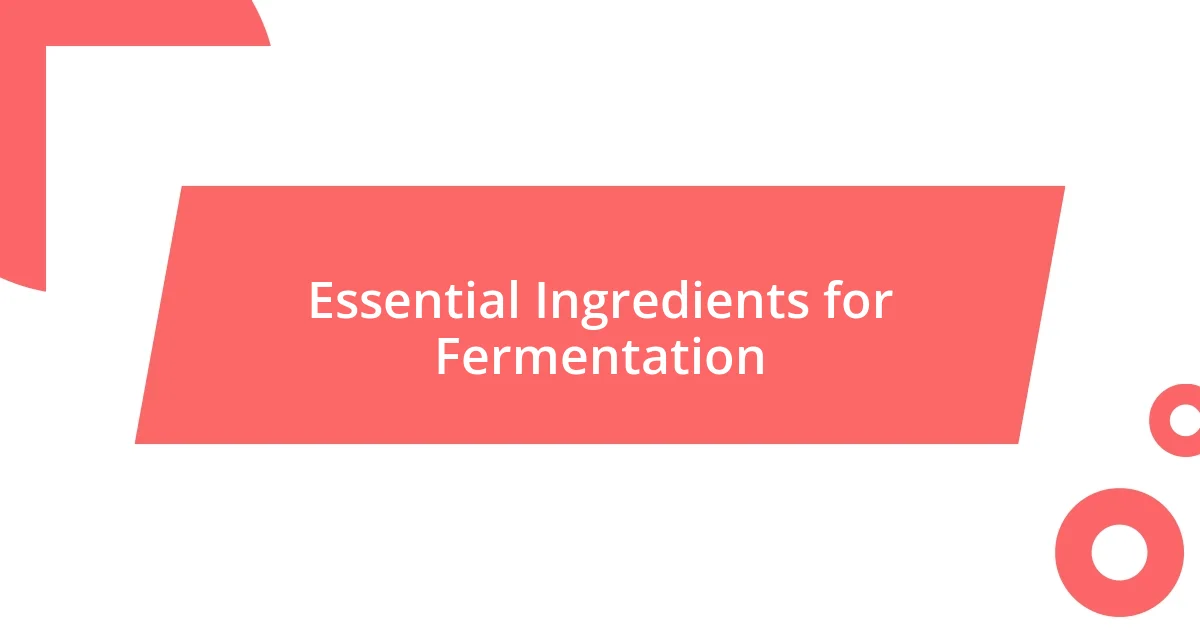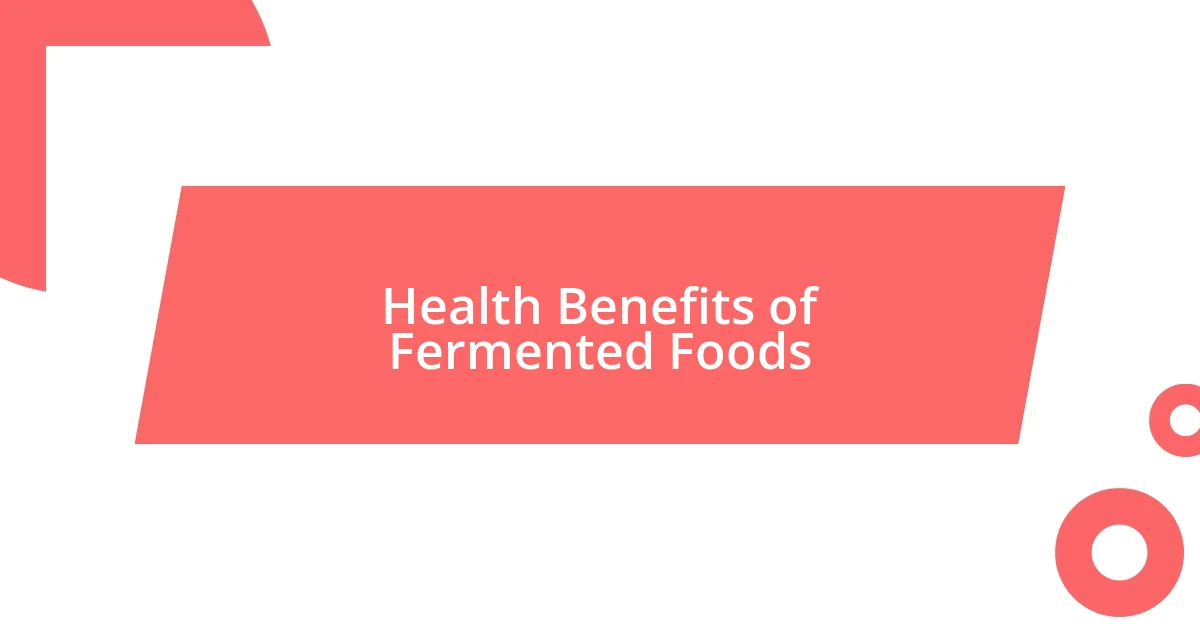Key takeaways:
- Traditional fermentation utilizes microorganisms to enhance food preservation and flavor, creating a satisfying connection to culinary history.
- Key ingredients for successful fermentation include fresh vegetables or fruits, salt, water, and optionally a starter culture, emphasizing the importance of quality ingredients.
- Fermented foods offer health benefits such as improved digestion, enhanced nutrient absorption, and strengthened immunity, making them a valuable addition to meals.

Introduction to Traditional Fermentation
Fermentation is a fascinating process that transforms simple ingredients into something magical. I still remember the first time I watched my grandmother prepare homemade sauerkraut. She would chop the cabbage, sprinkle salt, and then let it sit in a jar, creating an atmosphere filled with anticipation. Could such a simple combination really create such depth of flavor? The answer, as I’ve learned, is a resounding yes.
At its core, traditional fermentation harnesses the power of microorganisms, like bacteria and yeast, to enhance food preservation and nutritional value. This naturally occurring process has been a cornerstone of countless cultures for centuries. When I first tried my hand at making yogurt, I was astonished at how just a spoonful of store-bought yogurt could act as a starter for a whole new batch – it felt like a little culinary magic unfolding in my kitchen.
There’s something deeply satisfying about nurturing this age-old practice. It connects us to our ancestors and reminds us of the art of patience. As I watched my homemade kimchi bubbling away on the counter, I couldn’t help but wonder how many generations before me had experienced the same thrill of anticipation. Isn’t it remarkable how a little time and care can create flavors that dance on the palate?

Understanding the Fermentation Process
Understanding fermentation is like peeling back the layers of an intricate story. It begins with microorganisms, primarily yeast and bacteria, that feast on sugars in the food. I often think about the first time I made sourdough bread. Watching the yeast work its magic was similar to witnessing a tiny world come to life. The dough would bubble and rise, filled with potential. It made me ponder how these invisible beings have been creating flavor and texture long before we understood their significance.
The fermentation process varies greatly depending on the ingredients used, the environment, and the desired outcome. For instance, when I experimented with fermenting vegetables, I was surprised to find how each batch brought out its own unique flavors. It’s like creating distinct personalities in a room full of friends. The cabbage might develop a tangy bite one time and something smoother another. This unpredictability is what makes fermentation thrilling and deeply personal.
Fermentation is not just a method but a journey of discovery. Each time I engage with the process, it’s an opportunity to connect with nature, history, and my own palate. I vividly recall the first time I tasted homemade miso. The rich, umami flavor transported me to a small Japanese village, even though I was at home in my kitchen. This is the beauty of fermentation; it allows us to craft experiences and memories through food.
| Factor | Impact on Fermentation |
|---|---|
| Microorganisms | Different strains create varied flavors and textures. |
| Temperature | Affects the speed and type of fermentation; warmer is typically faster. |
| Ingredients | Freshness and quality influence the final product. |

Essential Ingredients for Fermentation
When it comes to fermentation, the ingredients you choose play a pivotal role. Each component contributes its own character to the final product, much like cast members in a play. My first encounter with essential ingredients was a memorable one—picking fresh cucumbers from my garden, I realized how the quality and freshness of ingredients can truly shape the fermentation experience. It’s like a personal touch that enhances every bite.
Here are the essential ingredients to get started with fermentation:
- Vegetables or Fruits: Cabbage, cucumbers, or even apples are popular choices.
- Salt: It acts as a preservative and helps create a brine, fostering the right environment for desirable bacteria.
- Water: Clean, non-chlorinated water ensures that your fermentation starts off on the right foot.
- Starter Culture (optional): This could be a spoonful of previously fermented food or a commercial starter, providing beneficial bacteria.
- Spices and Flavorings: Garlic, ginger, or even chili flakes can add depth and personalize your fermented concoction.
The beauty of fermentation lies in its simplicity, and yet, it also offers endless possibilities for experimentation. I remember my first attempt at pickling. I added dill and peppercorns, instantly transforming the ordinary into something extraordinary. There’s a joy in discovering how such minimal ingredients can create complexity and excitement. Embracing the essential ingredients is not just about food; it’s about unleashing creativity and savoring the process.

Step-by-Step Fermentation Techniques
When diving into fermentation, the step-by-step techniques can make or break your culinary adventure. I vividly recall one evening spent brining cabbage for kimchi. As I mixed the salt with water, I felt a rush of anticipation—could this blend of spices and veggies transform into something astonishing? Simply combining the salt and water creates a brine that facilitates the entire fermentation process. It’s that first step where you realize you’re not just cooking; you’re crafting a living, breathing creation.
Once your brine is ready, the next stage is to pack your ingredients tightly in a clean glass jar. I remember the satisfying sound of crunching fresh vegetables as I pressed them down. It reminded me that airlock is crucial in this stage—removing air prevents unwanted bacteria from spoiling your creation. At this point, I often wonder, “How will each ingredient’s essence meld together?” This is the magic of fermentation, where flavors clash and combine in unexpected ways.
Finally, let the jars sit in a cool, dark place, ideally for one to two weeks. I often experience a wave of impatience during this time—it’s like watching paint dry! But every day of waiting is rewarding. The bubbling sounds and fragrant aromas assured me that something wonderful was happening inside. This crucial waiting period is where the transformation takes place; it’s a beautiful reminder that good things take time, whether in cooking or life.

Troubleshooting Common Fermentation Issues
Sometimes, fermentation doesn’t go as planned, and that can be disheartening. I remember a batch of sauerkraut that smelled off when I opened the jar. It was a reminder to check my salt concentration and ensure I used a clean, sanitized jar. If you notice an unwelcome odor or mold, it’s crucial to assess the situation carefully—sometimes just removing the affected part can save the rest, but when in doubt, it’s safer to toss it out.
Another common issue I’ve encountered is fizzing that’s too aggressive when I open a jar. It’s a bit like that moment when you shake a soda can and then open it, only to face the eruption! This can occur from too much sugar in the brine or a thriving culture. I learned that adjusting the sugar content can lead to a more balanced ferment. Have you experienced an explosive opening? It’s a fun story to tell, but it can be messy!
And then there’s the challenge of fermentation that seems too slow. I once found myself peering at a jar of pickles for days, wondering if they were doing anything at all. It turns out, patience is key. I discovered that temperature plays a significant role; a warmer environment speeds up the process. Sometimes, relocating your jars to a slightly warmer spot can work wonders. Trust me, the wait will be worth it when you finally taste that tangy goodness!

Health Benefits of Fermented Foods
Fermented foods offer a wealth of health benefits that have me excited every time I incorporate them into my meals. For instance, when I first began enjoying yogurt, I noticed a significant improvement in my digestion. It turns out that the probiotics in fermented foods like yogurt, kefir, and sauerkraut can enhance gut health by promoting a balanced microbiome. Have you ever wondered why your stomach feels calmer after a meal with these foods? That’s the magic of beneficial bacteria working!
Another remarkable aspect of fermentation is its ability to enhance nutrient absorption. I learned this the hard way while prepping meals full of raw vegetables. When I transitioned to fermented versions, such as kimchi or pickled veggies, I could actually feel the difference. The fermentation process breaks down nutrients into a more accessible form, making it easier for our bodies to absorb vitamins and minerals. It’s truly fascinating how something as simple as fermentation can unlock a treasure trove of nutrients hidden in our food.
One of the emotional highs I experience with fermented foods is the boost in my immune system. After a long winter of colds and flu, I began experimenting with different fermented options like kombucha and miso soup. I felt a noticeable difference in my overall energy levels and resilience against illness. Can you believe that just adding these foods to my diet made such a tangible difference? It’s comforting to think that these age-old methods of food preservation can also help fortify our health in modern times.

Storing and Using Fermented Products
When it comes to storing fermented products, I’ve found that the right containers can make all the difference. After a few mishaps with flimsy jars that led to leaks, I switched to sturdy glass containers with airtight lids. These not only keep the flavors locked in but also allow me to see the vibrant colors of my creations, which is honestly a joy in itself. Have you ever been thrilled just by the sight of your beautifully fermented food?
Once stored, I like to keep my ferments in the fridge. It slows down the fermentation process and helps preserve that tangy flavor we all love. I remember the first time I pulled out a jar of pickles after several weeks and was completely blown away by their crunchiness and bite. But what I truly cherish is that they can last for months—talk about a hidden treasure in the back of the fridge! There’s something satisfying about knowing I have my homemade goodies just waiting to jazz up a meal.
Using fermented products is an adventure as well. Whether topping off a taco with sauerkraut or tossing kimchi into a stir-fry, they can elevate a dish into something extraordinary. I still recall a dinner party where I served homemade beet kvass; everyone was intrigued! The way these flavors can surprise and delight visitors always brings me joy. Have you ever experimented with adding fermented foods to your cooking? It’s amazing how just a little twist can transform the ordinary into something exceptional.















